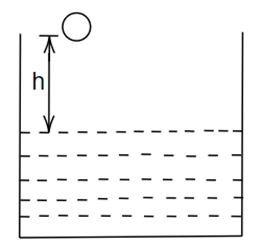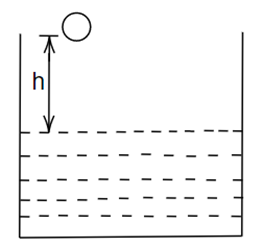
A ball of radius r and density \[\rho \] falls freely under gravity through a distance h before entering the water. The velocity of the ball does not change even on entering the water. The viscosity of water is \[\eta \], and the value of h is given by?

A. \[\dfrac{2}{9}{r^2}\left( {\dfrac{{1 - \rho }}{\eta }} \right)g\]
B. \[\dfrac{2}{{81}}{r^2}\left( {\dfrac{{\rho - 1}}{\eta }} \right)g\]
C. \[\dfrac{2}{{81}}{r^4}{\left( {\dfrac{{\rho - 1}}{\eta }} \right)^2}g\]
D. \[\dfrac{2}{9}{r^4}{\left( {\dfrac{{\rho - 1}}{\eta }} \right)^2}g\]
Answer
220.2k+ views
Hint: The property of a fluid that opposes the relative motion between its different layers is known as viscosity. The force that opposes the motion between the layers of fluid is known as viscous force.
Formula Used:
To find the terminal velocity the formula is,
\[{v_T} = \dfrac{{2{r^2}\left( {\rho - \sigma } \right)g}}{{9\eta }}\]
Here,
r is radius of ball
\[\rho \] is density of ball
\[\sigma \] is density of liquid
\[\eta \] is coefficient of viscosity of liquid
g is acceleration due to gravity
Complete step by step solution:

Image: A ball falling freely under gravity through a distance h before entering the water.
Once the ball enters into the liquid, the speed remains the same, it will not change. Here the velocity is nothing but \[v = \sqrt {2gh} \]. We are using this formula since the fall is free fall we can use the equations of motion.
Once it enters the liquid the velocity of the ball will not change but usually what happens the acceleration of the ball continuously decreases and at one particular instant the acceleration will be completely ceased by the resultant forces, one is buoyancy force and the other one is the viscous force. Here the coefficient of viscosity is \[\eta \].
Now, the formula for the terminal velocity is,
\[{v_T} = \dfrac{{2{r^2}\left( {\rho - \sigma } \right)g}}{{9\eta }}\]
The velocity just before entering the water is,
\[v = \sqrt {2gh} \]
When, \[v = {v_T}\]
\[\sqrt {2gh} = \dfrac{{2{r^2}\left( {\rho - 1} \right)g}}{{9\eta }}\]
Squaring on both the sides we obtain,
\[2gh = \dfrac{{4{r^4}{{\left( {\rho - 1} \right)}^2}{g^2}}}{{{9^2}{\eta ^2}}}\]
\[\Rightarrow h = \dfrac{{2{r^4}{{\left( {\rho - 1} \right)}^2}g}}{{81{\eta ^2}}}\]
\[\therefore h = \dfrac{2}{{81}}{r^4}{\left( {\dfrac{{\rho - 1}}{\eta }} \right)^2}g\]
Therefore, the value of h is \[\dfrac{2}{{81}}{r^4}{\left( {\dfrac{{\rho - 1}}{\eta }} \right)^2}g\].
Hence, option C is the correct answer.
Note: Remember that the viscous force and frictional force are similar, but they are not the same. In a moving fluid, the fluid consists of multiple layers. If we compare to the neighbouring layers each layer has a noticeable difference in speed. This force, called the frictional force, decreases the relative motion between the layers.
Formula Used:
To find the terminal velocity the formula is,
\[{v_T} = \dfrac{{2{r^2}\left( {\rho - \sigma } \right)g}}{{9\eta }}\]
Here,
r is radius of ball
\[\rho \] is density of ball
\[\sigma \] is density of liquid
\[\eta \] is coefficient of viscosity of liquid
g is acceleration due to gravity
Complete step by step solution:

Image: A ball falling freely under gravity through a distance h before entering the water.
Once the ball enters into the liquid, the speed remains the same, it will not change. Here the velocity is nothing but \[v = \sqrt {2gh} \]. We are using this formula since the fall is free fall we can use the equations of motion.
Once it enters the liquid the velocity of the ball will not change but usually what happens the acceleration of the ball continuously decreases and at one particular instant the acceleration will be completely ceased by the resultant forces, one is buoyancy force and the other one is the viscous force. Here the coefficient of viscosity is \[\eta \].
Now, the formula for the terminal velocity is,
\[{v_T} = \dfrac{{2{r^2}\left( {\rho - \sigma } \right)g}}{{9\eta }}\]
The velocity just before entering the water is,
\[v = \sqrt {2gh} \]
When, \[v = {v_T}\]
\[\sqrt {2gh} = \dfrac{{2{r^2}\left( {\rho - 1} \right)g}}{{9\eta }}\]
Squaring on both the sides we obtain,
\[2gh = \dfrac{{4{r^4}{{\left( {\rho - 1} \right)}^2}{g^2}}}{{{9^2}{\eta ^2}}}\]
\[\Rightarrow h = \dfrac{{2{r^4}{{\left( {\rho - 1} \right)}^2}g}}{{81{\eta ^2}}}\]
\[\therefore h = \dfrac{2}{{81}}{r^4}{\left( {\dfrac{{\rho - 1}}{\eta }} \right)^2}g\]
Therefore, the value of h is \[\dfrac{2}{{81}}{r^4}{\left( {\dfrac{{\rho - 1}}{\eta }} \right)^2}g\].
Hence, option C is the correct answer.
Note: Remember that the viscous force and frictional force are similar, but they are not the same. In a moving fluid, the fluid consists of multiple layers. If we compare to the neighbouring layers each layer has a noticeable difference in speed. This force, called the frictional force, decreases the relative motion between the layers.
Recently Updated Pages
Mass vs Weight: Key Differences Explained for Students

Electricity and Magnetism Explained: Key Concepts & Applications

JEE Energetics Important Concepts and Tips for Exam Preparation

JEE Isolation, Preparation and Properties of Non-metals Important Concepts and Tips for Exam Preparation

JEE Main 2021 July 25 Shift 1 Question Paper with Answer Key

JEE Main 2021 July 22 Shift 2 Question Paper with Answer Key

Trending doubts
JEE Main 2026: Application Form Open, Exam Dates, Syllabus, Eligibility & Question Papers

Understanding Uniform Acceleration in Physics

Derivation of Equation of Trajectory Explained for Students

Hybridisation in Chemistry – Concept, Types & Applications

Understanding the Angle of Deviation in a Prism

How to Convert a Galvanometer into an Ammeter or Voltmeter

Other Pages
Thermodynamics Class 11 Physics Chapter 11 CBSE Notes - 2025-26

JEE Advanced Marks vs Ranks 2025: Understanding Category-wise Qualifying Marks and Previous Year Cut-offs

Units And Measurements Class 11 Physics Chapter 1 CBSE Notes - 2025-26

NCERT Solutions For Class 11 Physics Chapter 8 Mechanical Properties Of Solids

Motion in a Straight Line Class 11 Physics Chapter 2 CBSE Notes - 2025-26

NCERT Solutions for Class 11 Physics Chapter 7 Gravitation 2025-26




